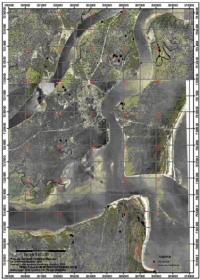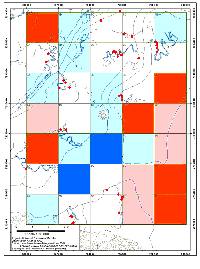|
IUCN/SCC Otter Specialist Group Bulletin
©IUCN/SCC Otter Specialist Group
Volume 22 Issue 1 Pages 1 -
44 (April 2005)
Citation: Silva, R.E., Nakano-Oliviera, E. & Monteiro-Filho, E.L.A. (2005) Methodology For Test Occurrence And Distribution Of Neotropical Otter
(Lontra Longicaudis, Olfers, 1818) In Cananéia, South Coast Of The State Of São Paulo, Brazil. IUCN Otter Spec. Group Bull. 18(1): 29 - 33
Previous | Contents | Next
Methodology For Test Occurrence And Distribution Of Neotropical Otter
(Lontra Longicaudis, Olfers, 1818) In Cananéia, South Coast Of The State Of São Paulo, Brazil
Roberta E. Silva1,2,Eduardo Nakano-Oliveira2,3 & Emygdio L.A. Monteiro-Filho2,4
¹ Mackenzie Presbiterian University, e-mail: robertaelise@yahoo.com.br
² Instituto de Pesquisas Cananéia, IPeC, www.ipecpesquisas.org.br
³ Universidade Estadual de Campinas, UNICAMP
4 Universidade Federal do Paraná, UFPR
Abstract: For a further distribution and occurrence study of L. longicaudis in the region of Cananéia, south coast of the State of São Paulo, Brazil, a methodology adapted for the local conditions based on the “survey” method used with Lutra lutra was tested. The study site was divided in 35 quadrants of 2x2 km and in each one a body of water was chosen for the investigation. Each body of water was traveled for at least 2 km searching for evidences of the presence of otters. It was possible to produce an image of the distribution of the species in the area using the coordinates of the sites where the vestiges were found. This image showed the presence of otters in rivers and in the estuary and absence in the areas facing the open sea. In 12 out of 13 positive quadrants for the otter presence the first vestige was found in the first 800 m of monitoring. Therefore, we recommend a reduction of the area traveled in each bodies of water to 1 km, reducing the expenses and also increasing the sampled area. We also recommend the increase in the size of the quadrants due to the occurrence of otters in some quadrants considered negative by the method. |
| Française | Español |
Taking into consideration that the neotropical otter, Lontra longicaudis, is one of the less studied species of otters, a new methodology to verify their occurrence and distribution was tested in a part of the south coast of the State of São Paulo, southeast of Brazil, which is inserted in one of the largest remains of the Atlantic Forest (SMA, 1998). The method used was adapted from a methodology tested for L. longicaudis between 2002 and 2003 in the regions of State of Rio de Janeiro and State of Rio Grande do Sul by Waldemarin (2004), which was based on the “survey” method used for the Eurasian otter (Lutra lutra) proposed by REUTHER et al. (2000). The method was tested to the south of Ilha Comprida island and Ilha de Cananéia islands, to the north of Ilha do Cardoso island and part of the continent (of 25°00’ to 25°04' S and 47°54' to 47° 56' W) where carnivores have been studied for about four years by the Carnivore Project of Instituto de Pesquisas Cananéia, IPeC (Nakano-Oliveira, in press).
The sampling site was divided in 35 quadrants of 2 x 2 km and in each one a body of water was chosen (a river, a lake or a marine coast) to be investigated searching for evidences of the presence of L. longicaudis. The rivers were prioritized in the moment of choice and the most central one in each quadrant was chosen to be traveled. A minimum distance of 2 km was investigated in the margins of this body of water and the distance of the first vestige found in relation to the monitoring starting point was recorded using a navigation GPS (Garmin, 12 XP). If no vestige is found, the method suggests covering an extra distance of at most 3 km or until the first vestige is found. This information would be useful to confirm that we would not consider negative a quadrant where there actually are otters, but in most cases we reached the end of the quadrant before finishing the extra course.
The quadrants that didn't have any type of body of water that could be investigated were considered null.
According to the method 13 quadrants were considered positive, 14 negative and 8 null (Fig. 1 and 2).
 |
 |
| Figure 1. Aerial photography of the distribution of the vestiges of Lontra longicaudis in the study area.
(click for larger version) |
Figure 2. Map of the distribution of the vestiges of Lontra longicaudis in the study area.
(click for larger version) |
 |
Sites where vestiges were found. |
 |
Positive quadrants. |
 |
Null quadrants where the presence of L. longicaudis was never registered |
 |
Null quadrants where the presence of L. longicaudis has already been registered |
 |
Negative quadrants where the presence of L. longicaudis was never registered |
 |
Negative quadrants where the presence of L. longicaudis has already been registered |
|
The presence of otters was confirmed in several quadrants (see Nakano-Oliveira, 2004) considered negative and null by the method used, showing a lack of independence among the quadrants. So we recommend that a new test should be carried out using larger quadrants so that an area where actually there are otters is not considered negative.
The minimum distance used for the monitoring area (2 km) was confirmed as excessive, once in 12 out of 13 positive quadrants (92.3%) the first vestige was found at a maximum distance of 800 m in relation to the monitoring starting point. Therefore, the minimum distance that should be traveled can be reduced to 1 km so that there is less than 10% of chance of considering negative a quadrant where the species actually occur and thus reducing the costs of the research and allowing the increase of the sampled area.
ACKNOWLEDGEMENTS - to Instituto de Pesquisas Cananéia, IPeC, Fudação O Boticário de Proteção à Natureza, The Nature Conservancy do Brasil and IDEA WILD for all the support; to Luciana Nakano C. de Oliveira for the revision of the paper; to Rebeca Pires Wanderley and Clovis for helping in the field; to Centro Nacional de Pesquisas para Conservação de Predadores Naturais CENAP/IBAMA for the permissions for catching carnivores (licence # 044/03).
REFERENCES
Nakano-Oliveira, E., Fusco, R., Santos, E. A. V., Monteiro- Filho, E., L., A. (2004). New information about the behavior of Lontra longicaudis (Carnívora: Mustelidae) by radio-telemetry. IUCN Otter Specialist Group Bulletin 21: 31-35.
Reuther, C., Dolch, D., Green, R., Jahrl, J., Jefferies, D., Krekemeyer, A., Kucerova, M., Madsen, A. B., Romanowski, J., Roche, K., Ruiz-Olmo, J., Teubner, J., Trindade, A. (2000). Survey and monitoring distribution and population trends of the Eurasian otter (Lutra lutra). Guidelines and evolution of the standard method for surveys as recommended by the European section of the IUCN/SSC Otter Specialist Group. Habitat Arbeitsberichte der AKTION FISCHOTTERSCHUTZ e.v.
SMA (1998). Mapeamento dos Ecossistemas Costeiros do Estado de São Paulo. CETESB, São Paulo, 108 p.
Waldemarin, H.F., Kasper, C. B., Rodrigues, L.A., Rheingantz, M., Andrade, R.G. (2004). Neotropical otters (Lontra longicaudis): testing methods to access distribution. In: IX International Otter Colloquium, Frostburg. Abstracts.
Résumé : Test d ’une Méthodologie l’Occurrence et la Distribution de la Loutre à Longue Queue (Lontra longicaudis, Olfers, 1818) à Cananéia, sur la Côte Sud de l’État de São Paulo, au Brésil
Pour une prochaine étude de la distribution et de l’occurrence de L. longicaudis dans la région de Cananéia, sur la côte sud de l’état de São Paulo au Brésil, une méthode basée sur la "méthode d’étude" utilisée pour Lutra lutra et adaptée aux conditions locales, a été testée. La zone d’étude a été divisée en 35 carrés de 2x2 km et une étendue d’eau à prospecter a été choisie au sein de chaque carré. Chaque étendue d’eau a été parcourue sur 2 km, afin d’y rechercher les indices de présence de la loutre. Il a été possible d’obtenir une estimation de la distribution de l’espèce, à partir des coordonnées des sites où des indices de présence ont été trouvés. Cette carte montra la présence de la loutre dans les rivières et les estuaires et son absence dans les secteurs faisant face à la pleine mer. Dans 12 des 13 carrés positifs, le premier indice de présence de la loutre a été trouvé dans les 800 premiers mètres prospectés. C’est pourquoi, nous recommandons de ramener la distance prospectée sur chaque étendue d’eau à 1 km, ce qui permet de réduire les dépenses et d’augmenter l`étendue de la zone prospectée. Nous recommandons également d’augmenter la taille des cadrats, en raison de la présence de loutres dans certains carrés donnés comme négatifs par cette méthode.
Revenez au dessus
Resumen: Presencia y Distribución de la Nutria de Río Neotropical (Lontra longicaudis, Olfers 1818) en Cananéia, Costa sur del Estado de San Pablo, Brasil
La metodología de relevamiento usada con Lutra lutra fue adaptada y testeada para estudiar la presencia y distribución de la nutria de río Neotropical (Lontra longicaudis, Olfers 1818) en Cananéia, costa sur del estado de San Pablo, Brasil. El sitio de estudio fue dividido en 35 cuadrantes de 2x2 km, y un cuerpo de agua fue muestreado en cada cuadrante. Al menos 2 km fueron muestreados en cada cuerpo de agua para detectar la presencia de nutrias de río. Con las coordenas donde se detectó la presencia de nutrias se generó una imagen de su distribución. Esta imagen mostró lo presencia de nutrias en ríos, estuarios, pero su ausencia en areas enfrentadas con mar abierto. En 12 de los 13 cuadrantes donde se detectaron nutrias, evidencias de su presencia fue detectada en los primeros 800 m muestreados. Así, nosotros recomendamos reducir la distancia recorrida en cada cuerpo de agua a 1 km, lo que reduce los costos y además incrementa el area muestreada. Además recomendamos incrementar el tamaño de los cuadrantes dada la presencia de nutrias en algunos cuadrantes considerados negativos por la metodología.
Vuelva a la tapa
Previous | Contents | Next
|


